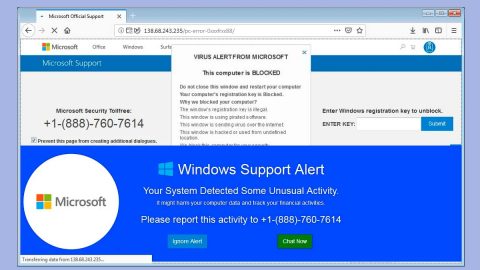What is Thanatos ransomware? And how does it carry out its attack?
Thanatos ransomware is a malicious program designed to lock files using an encryption algorithm. This generic file-encoding Trojan first appeared on February 17, 2018. According to researchers, it reaches a system through phishing messages that may look like it was sent by trusted companies like Amazon, eBay, Facebook and so on. Based on the initial analysis done by security experts, it seems that Thanatos ransomware uses a modular framework. Meaning to say, any future updates that will be applied on this crypto-malware can reshape it and model the strains in an entirely different manner.
Thanatos ransomware is programmed to target several data types, which according to researchers are as follows:
.txt, .doc, .docx, .xls, .xlsx, .pdf, .pps, .ppt, .pptx, .odt, .gif, .jpg, .png, .db, .csv, .sql, .mdb.sln.php, .asp, .aspx, .html, .xml, .psd, .frm, .myd, .myi, .dbf, .mp3, .mp4, .avi, .mov, .mpg, .rm, .wmv, .m4a, .mpa, .wav, .sav, .gam, .log, .ged, .msg, .myo, .tax, .ynab, .ifx, .ofx, .qfx, .qif, .qdf, .tax2013, .tax2014, .tax2015, .box, .ncf, .nsf, .ntf, .lwp
Thanatos ransomware makes use of a resource fork file containing all the malware commands. This kind of infection is a specific one that in some cases can be used to conceal information and hacker-set parameters. Aside from that, Thanatos ransomware also contains information about extracting module that can query the operating system kernel. The malware engine can collect the list of all the running processes and terminate all of them so that it can carry out its attack without any interference.
The information harvesting module found in Thanatos ransomware has been found to collect information about the infected PC as well as information about the user. Usually, the kind of information gathered is classified into two – one is anonymous data while the second one is personally identifiable information.
In addition, Thanatos ransomware also modifies the Registry so it can run on every startup. However, what has security experts worried is that this crypto-malware is found to be bundled with the Thanatos virus which can modify the proxy settings of the infected computer. As a result, the compromised computer routes all the internet traffic through the hacker-controlled server which allows cyber crooks to utilize man-in-the-middle attacks and spy on its victims. Not only that, as this threat can also download files prior to the encryption process. Once Thanatos ransomware is done carrying out its attack, it drops a file named README.txt which contains the following message:
“Your computer is encrypted. All data will be lost if you do not pay 0.01 BTC to the specified BTC wallet
1DRAsxW4cKAD1BCS9m2dutduHi3FKqQnZF
after payment, you will receive the decryption code from this mail
[email protected]”
How does Thanatos ransomware spread its malicious payload?
Thanatos ransomware may spread as an infected attachment in spam emails that care sent out by crooks, making the email look like it was sent out by a famous company like Amazon, eBay, etc. which is why you have to be careful when you encounter these kinds of emails because chances are, it might contain a malicious payload of harmful cyber threats like Thanatos ransomware. It would also be best if you always keep your antivirus program and system updated to guard your system against malware and other viruses.
Refer to the following removal instructions to obliterate Thanatos ransomware from your PC.
Step 1: Open the Task Manager simply by tapping Ctrl + Shift + Esc keys on your keyboard.
Step 2: Under the Task Manager, go to the Processes tab and look for a process named “WINDOWSUI.exe” and other suspicious-looking processes that could be related to Thanatos ransomware.

Step 3: After that, close the Task Manager.
Step 4: Tap Win + R, type in appwiz.cpl and click OK or tap Enter to open Control Panel’s list of installed programs.
Step 5: Under the list of installed programs, look for Thanatos ransomware or anything similar and then uninstall it.

Step 6: Next, close Control Panel and tap Win + E keys to launch File Explorer.
Step 7: Navigate to the following locations below and look for Thanatos ransomware’s malicious components such as [random].exe and how-to-decrypt-files.txt as well as other suspicious files and then delete all of them.
- %TEMP%
- %APPDATA%
- %ALLUSERSPROFILE%
- %ALLUSERSPROFILE%\Application Data
- %APPDATA%\Microsoft\Windows\Templates\
- %USERPROFILE%\Downloads
- %USERPROFILE%\Desktop
Step 8: Close the File Explorer.
Before you proceed to the next steps below, make sure that you are tech savvy enough to the point where you know exactly how to use and navigate your computer’s Registry. Keep in mind that any changes you make will highly impact your computer. To save you the trouble and time, you can just use PC Cleaner Pro, this system tool is proven to be safe and excellent enough that hackers won’t be able to hack into it. But if you can manage Windows Registry well, then, by all means, go on to the next steps.
Step 9: Tap Win + R to open Run and then type in regedit in the field and tap enter to pull up Windows Registry.

Step 10: Navigate to the following path:
- HKEY_CURRENT_USER\Control Panel\Desktop\
- HKEY_USERS\.DEFAULT\Control Panel\Desktop\
- HKEY_LOCAL_MACHINE\Software\Microsoft\Windows\CurrentVersion\Run
- HKEY_CURRENT_USER\Software\Microsoft\Windows\CurrentVersion\Run
- HKEY_LOCAL_MACHINE\Software\Microsoft\Windows\CurrentVersion\RunOnce
- HKEY_CURRENT_USER\Software\Microsoft\Windows\CurrentVersion\RunOnce
Step 11: Delete the registry keys and sub-keys created by Thanatos ransomware.
Step 12: Close the Registry Editor and empty your Recycle Bin.
It is important to make sure that nothing is left behind and that Thanatos ransomware is completely removed using the following antivirus program. To use it, refer to the instructions below.
Perform a full system scan using SpyRemover Pro. To do so, follow these steps:
- Turn on your computer. If it’s already on, you have to reboot
- After that, the BIOS screen will be displayed, but if Windows pops up instead, reboot your computer and try again. Once you’re on the BIOS screen, repeat pressing F8, by doing so the Advanced Option shows up.
- To navigate the Advanced Option use the arrow keys and select Safe Mode with NetServering then hit
- Windows will now load the SafeMode with NetServering.
- Press and hold both R key and Windows key.
- If done correctly, the Windows Run Box will show up.
- Type in explorer http://www.fixmypcfree.com/install/spyremoverpro
A single space must be in between explorer and http. Click OK.
- A dialog box will be displayed by Internet Explorer. Click Run to begin downloading the program. The installation will start automatically once a download is done.
- Click OK to launch it.
- Run SpyRemover Pro and perform a full system scan.
- After all the infections are identified, click REMOVE ALL.
- Register the program to protect your computer from future threats.
















